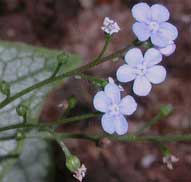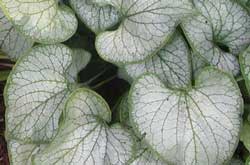Resource Library
Plant of the Week: Jack Frost
The University of Arkansas System Division of Agriculture does not promote, support or recommend plants featured in "Plant of the Week." Please consult your local Extension office for plants suitable for your region.
Plant of the Week
Jack Frost
Latin: Brunnera macrophylla

Perennials come and go in popularity. Those that pass the test to become garden staples share certain characteristics. First, they're tough, adaptable long-lived survivors that don't have a weedy soul. Of course, it helps if the plant is attractive and provides lots of eye candy, but if it isn't tough, it will never become a permanent fixture in the garden.
A new sport of an old perennial - Jack Frost Siberian Bugloss (Brunnera macrophylla Jack Frost) - has captured considerable attention since its introduction in 2001 by John Walters of Zeeland, Mich. Early reports indicate it may become a long-term garden performer, but check again in about a decade to make for sure it has made it over the hump.
'Jack Frost' (PP 13,859, June 2003) produces a 12- to 18-inch tall and wide mound of heart-shaped, herbaceous leaves that are a field of silver with green veins. It belongs to the borage family and begins the season by sending up a branched leafy shoot containing clusters of light blue, quarter-inch diameter, five-petaled forget-me-not flowers. After the flowers disappear its leaves continue to enlarge during the summer and reach 6 inches to 8 inches across.
The species is native to the Caucasus Mountains, not Siberia as the name implies. The Caucasus Mountains are an east - west range running between the Black and Caspian Sea and constitute part of the southern boundary between Europe and Asia. To the south lies Iran; to the north Russia. It was collected by Count Apollo Mussin-Puschkin (d. 1815), a Russian chemist and naturalist, when he explored the Caucasus' in 1802 north of Tabilisi in modern-day Georgia.

Like many plants, Siberian bugloss has had a long history of name changes, but since the 1930s the current name has been in use. The genus name is after Samuel Brunner (1790-1844), a specialist in the flora of Italy and North Africa and was first proposed in 1851. Bugloss is a Middle English translation of a Greek name (meaning ox tongue) used to describe the hairy leaves of several Mediterranean borages.
Though the Siberian bugloss was grown by collectors it never really caught on in European gardens until at least the middle of the 20th century. In the 1960s, a couple of cultivars had made their way to the United States. As perennials surged in popularity in the 1990s Waller was producing half dozen clones of the species when Jack Frost arose as a tissue culture sport in 1997 from an English cultivar called Langtrees.
Though Jack Frost produces a pretty display of airy blue flowers held above the foliage in early spring, its showy foliage is its main attraction. The silvery leaves appear early in the spring and persist until late fall. It's an ideal companion plant for hostas, Solomon's seal and other woodlanders where it can be used as a specimen or as a deciduous groundcover.
Jack Frost should be grown in rich organic soil that can be kept watered during the summer months. In the winter the site should be well drained. Avoid planting it in an area overrun by shallow tree roots; it is not a choice for dry shade. Jack Frost and its all-silver sport Looking Glass is hardy from zone 3 to 8. In northern areas, Jack Frost does best in an area with morning sun and afternoon shade. In the south, it's better in areas with high shade and no direct sun. If plants begin producing smaller leaves after several years, lift them in the fall or late winter and rework the soil by adding additional compost.
By: Gerald Klingaman, retired
Extension Horticulturist - Ornamentals
Extension News - November 16, 2007
The University of Arkansas System Division of Agriculture does not maintain lists of retail outlets where these plants can be purchased. Please check your local nursery or other retail outlets to ask about the availability of these plants for your growing area.